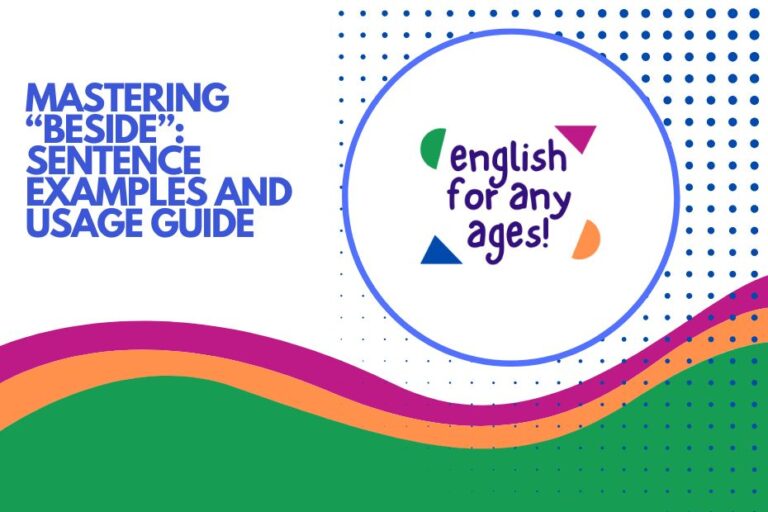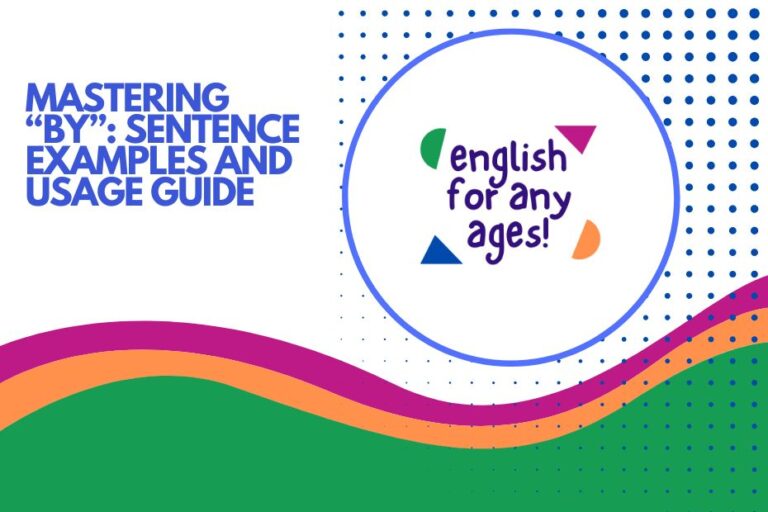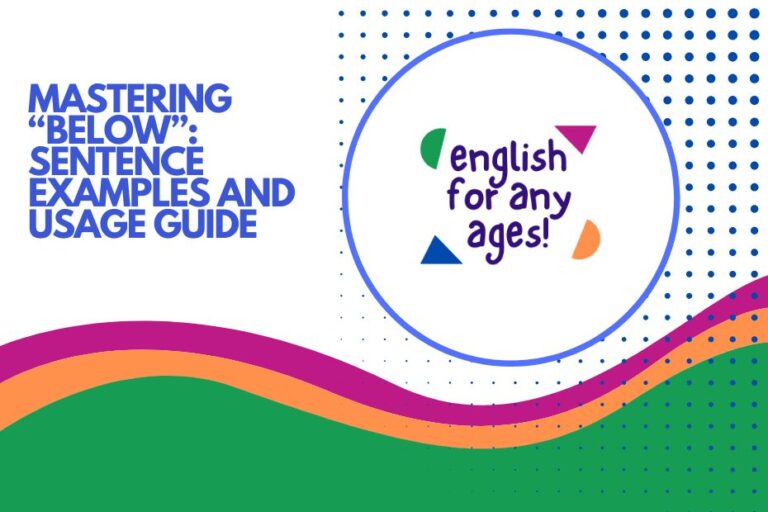Mastering “Throughout”: Sentence Examples and Usage Guide
The preposition “throughout” is a versatile word in the English language, indicating extension in space or time. A solid understanding of its usage is crucial for constructing clear and precise sentences.
This article provides a comprehensive guide to using “throughout” correctly, complete with numerous examples, helpful rules, and practical exercises. Whether you are an ESL learner or simply aiming to refine your grammar skills, this guide will equip you with the knowledge to confidently use “throughout” in your writing and speech.
Table of Contents
- Introduction
- Definition of “Throughout”
- Structural Breakdown
- Types and Categories of Usage
- Examples of “Throughout” in Sentences
- Usage Rules for “Throughout”
- Common Mistakes with “Throughout”
- Practice Exercises
- Advanced Topics
- Frequently Asked Questions
- Conclusion
Introduction
The preposition “throughout” is a powerful tool for expressing continuity, pervasiveness, and duration. It helps to paint a vivid picture in the reader’s mind, whether describing the distribution of something across a physical space or the persistence of something over a period of time.
This article serves as your comprehensive guide to mastering the nuances of “throughout.” By exploring its various applications, structural properties, and common pitfalls, you’ll gain a deeper understanding of how to use this preposition effectively and accurately. This guide is designed for learners of all levels, from those just starting their English language journey to advanced speakers seeking to polish their writing skills.
Let’s embark on a journey to unlock the full potential of “throughout” in your everyday communication.
Definition of “Throughout”
“Throughout” is a preposition that can function in several ways, primarily indicating extension either in space or time. It signifies that something exists or occurs in every part of a specified area or during the whole of a particular period.
In simpler terms, it means “in every part of” or “during the whole period of.” Understanding its core meaning is crucial before delving into more complex applications. “Throughout” is essential for conveying ideas of completeness and continuity.
The word “throughout” is best understood as a preposition because it always precedes a noun or noun phrase, connecting it to the rest of the sentence. It helps to describe the scope or extent of the action or state being described.
The word serves to modify and provide context to the nouns or noun phrases they precede. “Throughout” is a valuable word in English grammar and usage.
Structural Breakdown
The basic structure of a sentence using “throughout” involves placing the preposition before the noun or noun phrase it modifies. This noun phrase usually indicates a period of time or a physical area. The structure can be represented as: [Main Clause] + throughout + [Noun Phrase (Time or Space)]. The main clause establishes the action or state, while the “throughout” phrase specifies the duration or location of that action or state. Understanding this structure is key to constructing grammatically correct sentences.
For example, in the sentence “The music played throughout the night,” “the music played” is the main clause, and “throughout the night” is the prepositional phrase that specifies the duration of the music. Note that the noun phrase following “throughout” can be simple (e.g., “the day”) or more complex (e.g., “the entire history of the company”).
The flexibility of the noun phrase allows “throughout” to be used in a variety of contexts.
Types and Categories of Usage
“Throughout” can be broadly categorized into three main types of usage, each serving a distinct purpose in conveying meaning. These categories are: Throughout Space, Throughout Time, and Throughout a Condition or State.
Each category has its own nuances and applications. By understanding these distinctions, you can use “throughout” with greater precision.
Throughout Space
This usage refers to the distribution or presence of something across a physical area. It indicates that something is present or happening in every part of a specified location.
When used to describe space, “throughout” emphasizes the extent or reach of something, such as the spread of a disease or the presence of trees in a forest. This usage highlights the spatial distribution.
Throughout Time
This usage indicates that something continues or occurs during the entire duration of a specified time period. It signifies continuity and persistence.
When used to describe time, “throughout” emphasizes the duration or period over which something occurs, such as a trend that continues throughout the year or a feeling that lasts throughout the day. This usage focuses on temporal continuity.
Throughout a Condition or State
This usage refers to the persistence of a condition or state. It indicates that a particular condition or state remains consistent or prevalent.
This is a more abstract usage, as it does not specifically refer to space or time. For example, “Throughout his illness, he remained optimistic.” This usage emphasizes the consistency of a particular attribute.
Examples of “Throughout” in Sentences
To illustrate the different usages of “throughout,” let’s examine a wide range of examples. These examples are organized into the categories discussed above: Throughout Space, Throughout Time, and Throughout a Condition or State.
Each category includes multiple examples to provide a comprehensive understanding of how “throughout” can be used in various contexts.
Examples Indicating Space
The following table provides examples of sentences using “throughout” to indicate space. These examples demonstrate how “throughout” can describe the distribution or presence of something across a physical area.
| # | Sentence |
|---|---|
| 1 | The smell of freshly baked bread wafted throughout the house. |
| 2 | Security cameras are installed throughout the building. |
| 3 | Wildflowers bloomed throughout the meadow. |
| 4 | The company has offices throughout the country. |
| 5 | The news spread throughout the community like wildfire. |
| 6 | The sound of laughter echoed throughout the garden. |
| 7 | The river flows throughout the valley. |
| 8 | Police officers were stationed throughout the city during the parade. |
| 9 | The disease spread throughout the continent. |
| 10 | Ancient ruins are scattered throughout the region. |
| 11 | The forest extended throughout the mountain range. |
| 12 | The aroma of spices filled the air throughout the market. |
| 13 | The company’s products are sold throughout the world. |
| 14 | The internet is accessible throughout the campus. |
| 15 | The decorations were placed throughout the hall. |
| 16 | The music was piped throughout the store. |
| 17 | The protesters marched throughout the capital city. |
| 18 | The exhibition displayed artifacts from throughout the museum. |
| 19 | The soldiers patrolled throughout the area. |
| 20 | The network of tunnels extended throughout the city. |
| 21 | Banners were hung throughout the stadium. |
| 22 | The scent of pine trees permeated throughout the forest. |
| 23 | The survey was conducted throughout the state. |
| 24 | The light shone throughout the room. |
| 25 | The sound of the bell reverberated throughout the tower. |
| 26 | The project spanned communities throughout the region. |
| 27 | The support system was available throughout the facility. |
| 28 | The volunteers were stationed throughout the festival grounds. |
| 29 | The knowledge base is accessible throughout the organization. |
| 30 | The artist’s murals are visible throughout the neighborhood. |
Examples Indicating Time
The following table provides examples of sentences using “throughout” to indicate time. These examples demonstrate how “throughout” can describe the duration or period over which something occurs.
| # | Sentence |
|---|---|
| 1 | The store is open throughout the year. |
| 2 | She remained calm throughout the crisis. |
| 3 | He studied diligently throughout the semester. |
| 4 | The rain continued throughout the afternoon. |
| 5 | The festival lasted throughout the week. |
| 6 | The company has grown throughout its history. |
| 7 | The tradition has been maintained throughout the generations. |
| 8 | The team worked tirelessly throughout the project. |
| 9 | The exhibition will be on display throughout the summer. |
| 10 | The negotiations continued throughout the night. |
| 11 | The birds sang throughout the morning. |
| 12 | The program will run throughout the academic year. |
| 13 | The policy remained in effect throughout his administration. |
| 14 | The debate raged throughout the session. |
| 15 | The employees received training throughout the month. |
| 16 | The show has been popular throughout its run. |
| 17 | The research was conducted throughout the decade. |
| 18 | The agreement was honored throughout the period. |
| 19 | The construction continued throughout the winter. |
| 20 | The price of oil fluctuated throughout the day. |
| 21 | The business thrived throughout its early years. |
| 22 | The team practiced throughout the off-season. |
| 23 | The course is available throughout the year. |
| 24 | The monument stood tall throughout the centuries. |
| 25 | The festival was celebrated throughout the holiday season. |
| 26 | The company innovated throughout its existence. |
| 27 | The organization evolved throughout its development. |
| 28 | The artist experimented throughout his career. |
| 29 | The scientist researched throughout her lifetime. |
| 30 | The athlete trained throughout the competition. |
Examples Indicating Condition or State
The following table provides examples of sentences using “throughout” to indicate condition or state. These examples demonstrate how “throughout” can describe the persistence of a particular attribute.
| # | Sentence |
|---|---|
| 1 | Throughout his career, he remained dedicated to his work. |
| 2 | Throughout her illness, she showed incredible strength. |
| 3 | Throughout the investigation, he maintained his innocence. |
| 4 | Throughout the debate, she remained composed and articulate. |
| 5 | Throughout the challenges, they remained optimistic. |
| 6 | Throughout the process, he was supportive and encouraging. |
| 7 | Throughout the negotiation, they were flexible and collaborative. |
| 8 | Throughout the project, she remained committed to excellence. |
| 9 | Throughout the journey, he showed remarkable resilience. |
| 10 | Throughout the ordeal, she remained calm and collected. |
| 11 | Throughout the competition, he displayed sportsmanship. |
| 12 | Throughout the discussion, she showed respect for others’ opinions. |
| 13 | Throughout his tenure, he prioritized innovation. |
| 14 | Throughout her life, she championed social justice. |
| 15 | Throughout the controversy, he remained steadfast. |
| 16 | Throughout the transition, the company stayed focused on its goals. |
| 17 | Throughout the experiment, the scientist remained objective. |
| 18 | Throughout the performance, the artist captivated the audience. |
| 19 | Throughout the crisis, the leader showed decisive action. |
| 20 | Throughout the development, the team emphasized quality. |
| 21 | Throughout his reign, he promoted education. |
| 22 | Throughout her career, she mentored young professionals. |
| 23 | Throughout his term, he advocated for reform. |
| 24 | Throughout her journey, she documented her experiences. |
| 25 | Throughout the process, he sought feedback. |
| 26 | Throughout the conflict, they sought peaceful resolutions. |
| 27 | Throughout the program, they encouraged participation. |
| 28 | Throughout the initiative, they prioritized sustainability. |
| 29 | Throughout the collaboration, they fostered creativity. |
| 30 | Throughout the partnership, they emphasized trust. |
Usage Rules for “Throughout”
Several rules govern the correct usage of “throughout.” First, it should always be followed by a noun or noun phrase, indicating either a period of time or a physical area. Second, “throughout” implies completeness or pervasiveness; it suggests that something is present or happening in every part of the specified area or during the entire specified period.
Third, be mindful of the context to ensure that “throughout” accurately conveys your intended meaning. Understanding and adhering to these rules is essential for using “throughout” effectively.
Exceptions and Special Cases: While “throughout” generally follows the structure described above, there are some cases where it may be used more figuratively. For example, you might say “He showed courage throughout,” which implies “throughout the experience” or “throughout the situation.” These cases are often idiomatic and require careful attention to context.
Common Mistakes with “Throughout”
One common mistake is using “through” instead of “throughout.” “Through” indicates movement from one side to another, while “throughout” indicates extension across an area or duration. Another common error is misusing “throughout” when “during” or “in” would be more appropriate.
For example, saying “He was nervous throughout the meeting” might be better phrased as “He was nervous during the meeting” if the nervousness was not constant. Avoiding these errors will enhance the clarity and precision of your writing.
Here’s a table illustrating some common mistakes and their corrections:
| Incorrect | Correct | Explanation |
|---|---|---|
| The music played through the night. | The music played throughout the night. | “Through” implies movement; “throughout” indicates duration. |
| The company has offices through the country. | The company has offices throughout the country. | “Through” implies movement; “throughout” indicates distribution. |
| He was happy through the day. | He was happy throughout the day. | “Through” is less common for duration; “throughout” is more standard. |
| The rain fell through the afternoon. | The rain fell throughout the afternoon. | “Through” is generally incorrect; “throughout” indicates the entire period. |
Practice Exercises
Test your understanding of “throughout” with these practice exercises. Fill in the blanks with the correct use of “throughout” in each sentence.
These exercises cover the different usages of “throughout” discussed in this article. Remember to consider the context and meaning of each sentence.
| # | Question | Answer |
|---|---|---|
| 1 | The festival was celebrated ______ the town. | throughout |
| 2 | She remained dedicated ______ her career. | throughout |
| 3 | The news spread ______ the organization. | throughout |
| 4 | The store is open ______ the holiday season. | throughout |
| 5 | The security guards patrolled ______ the building. | throughout |
| 6 | The band toured ______ the summer months. | throughout |
| 7 | He maintained a positive attitude ______ the project. | throughout |
| 8 | She demonstrated leadership ______ her tenure. | throughout |
| 9 | The river flows ______ the valley. | throughout |
| 10 | The course is available ______ the year. | throughout |
More Challenging Exercises:
| # | Question | Answer |
|---|---|---|
| 1 | The principles of sustainability were implemented ______ the company’s operations. | throughout |
| 2 | He consistently displayed a commitment to excellence ______ his professional endeavors. | throughout |
| 3 | The impact of the economic reforms was felt ______ the various sectors of the economy. | throughout |
| 4 | The artist’s influence resonated ______ generations of painters and sculptors. | throughout |
| 5 | The organization’s mission to promote education was upheld ______ its global initiatives. | throughout |
| 6 | The research findings were validated ______ numerous studies and experiments. | throughout |
| 7 | The historical significance of the monument was recognized ______ the ages. | throughout |
| 8 | The cultural traditions were preserved ______ the communities in the region. | throughout |
| 9 | The spirit of innovation thrived ______ the company’s research and development departments. | throughout |
| 10 | The values of integrity and ethics were emphasized ______ the organization’s code of conduct. | throughout |
Advanced Topics
For advanced learners, consider exploring the nuances of using “throughout” in more complex sentence structures. For example, “throughout” can be used in conjunction with other prepositions to create more detailed descriptions.
It is also helpful to examine how “throughout” is used in formal writing and literature. Studying these advanced topics will deepen your understanding and mastery of “throughout.”
Another interesting area to explore is the use of “throughout” in comparative constructions. For example, “The use of technology increased throughout the decade, more so than in any previous period.” This type of sentence highlights the change or trend over a longer period of time.
As learners advance, it’s important to note the subtle differences in meaning between “throughout” and similar words like “during,” “across,” and “over.”
Frequently Asked Questions
Here are some frequently asked questions about the use of “throughout.” These questions address common concerns and misconceptions about this preposition.
- What is the difference between “through” and “throughout”?
“Through” indicates movement from one side to another, while “throughout” indicates extension across an area or duration. For example, “He walked through the door” vs. “He was happy throughout the day.” - Can “throughout” be used with uncountable nouns?
Yes, “throughout” can be used with uncountable nouns that represent a period of time or an area. For example, “throughout the history of the company” or “throughout the water.” - Is it always necessary to use a noun after “throughout”?
Yes, “throughout” is a preposition and must be followed by a noun or noun phrase. Otherwise, the sentence is grammatically incorrect. - Can “throughout” be used at the beginning of a sentence?
While less common, “throughout” can be used at the beginning of a sentence for emphasis. For example, “Throughout the crisis, she remained calm.” However, this usage should be used sparingly. - What are some alternatives to using “throughout”?
Alternatives include “during,” “across,” “over,” “in every part of,” and “for the duration of.” The best alternative depends on the specific context and the intended meaning. - How can I best practice using “throughout”?
Practice by writing your own sentences using “throughout” in different contexts. Also, pay attention to how “throughout” is used in books, articles, and other written materials. - Is “throughout” formal or informal?
“Throughout” is generally considered a neutral word that can be used in both formal and informal contexts. However, it is more common in formal writing than in casual conversation. - Can “throughout” be used to describe feelings or emotions?
Yes, “throughout” can be used to describe the duration or persistence of feelings or emotions. For example, “Throughout the movie, she felt a sense of sadness.”
Conclusion
Mastering the use of “throughout” is a valuable asset in enhancing your English language skills. By understanding its definition, structural properties, and various applications, you can effectively convey ideas of completeness, continuity, and pervasiveness.
This comprehensive guide has provided numerous examples, helpful rules, and practical exercises to solidify your understanding. Remember to practice regularly and pay attention to how “throughout” is used in real-world contexts.
With consistent effort, you will confidently and accurately use “throughout” in your writing and speech.
As you continue your language learning journey, remember that understanding the nuances of prepositions like “throughout” is key to achieving fluency and precision. By incorporating the knowledge gained from this guide into your daily communication, you will be well-equipped to express yourself clearly and effectively.
Keep practicing, keep exploring, and embrace the power of language!






